Pacific Northwest Cordyceps Encounters Unfortunately, we are finding cordyceps fungi much too rarely in the PNW. I have found these insect parasitizing fungi in Asia, South America and Europe as well as on the East Coast. In all these locations one finds more specimens and in most locations also much higher species diversity. On a good day in the Amazon I found five different species; In the Appalachian mountains a mushroom friend took me to a spot where we found four different species. In the PNW I have not heard of a spot where people found two different species at the same time. The only species found somewhat frequently is Tolypocladium capitatum, a deer truffle parasitizing cordyceps (see below). Interestingly, we keep finding new species, i.e. Paraisaria! Here a few species I ran into through the years. Ophiocordyceps variabilis (Petch.) G.H. Sung, J.M. Sung, Hywel-Jones & Spatafora (= Cordyceps variabilis Petch.)  The stroma of Ophiocordyceps variabilis growing out of the softish rotten wood of a fallen Red alder (Alnus rubra). Not visible here is the "host" or more to the point, the victim of the parasitizing fungus, the larva of a wood boring fly (see below), which is embedded in the wood. The white areas will turn into the spore producing perithecia. At this point they are still differentiating.
On the surface of the mature stroma (the fruiting body of fungus) are pillow-like clusters of perithecia, the tissue which contains the asci. In each ascus eight spores are usually produced. The darker dots on the perithecia are ostioles, openings out if which the spores are ejected once mature. Cordyceps perithecia can be superficial as in this species or they can be immersed, meaning integrated in the tissue of the stroma (see below the case of Tolypocladium capitatum).
The specimens above were all found in Bridle Trail State Park, Kirkland, WA, USA in mid June 2021 by Heidi Schor and me. In 2024 (see below) I found another specimen on the same alder trunk, that had deteriorated quite a bit more at this point. The stroma was still very and no fertile tissue has grown yet.  Below the same Ophiocordyceps variabilis stroma 7 days later. I expect the white areas to turn into perithecia.  ******************************************************************************************************************** Ophiocordyceps myrmecophila (Ces.) G.H. Sung, J.M. Sung, Hywel-Jones & Spatafora (= Cordyceps myrmecophila Ces.)
So hard to spot these fungi! Check out the size of the drum stick shaped stroma in comparison to the Douglas fir needle
 Ophiocordyceps myrmecophila parasitizing Camponotus modoc ants. Seen on May 6, 2022 in Whidbey Island. Discovered first by Travis Furlanic of Whidbey Wild Mushroom Tour who rook me to his spot, thanks so much! +++++++++++++++++++++++++++++++++++++++++++++++++++++++++++++++++++++++++++++++++++++++++++++++++++++++++++ Paraisaria cascadensis Tehan, Dooley & Spatafora 2023 An exciting new cordyceps species endemic to the Pacific Northwest first described in 2023!  Paraisaria cascadensis buried in soil in situ in Washington State's Chelan County in 2838ft / 865 m asl.. It was collected by Daniel Winkler and Hans Drabicki, a week after Eric Jain reported the site on iNaturalist. Based on coordinates and Erics instructions it took us 25 min of search to find it. We dug it up to conserve the specimen and sent it to Rich Tehan, who included it in the description of this new species (Tehan, Dooley & Spatafora 2023).  Excavated and cleaned the Monster Haglid, Cyphoderris monstrosa, out of which grew the stroma of Paraisaria cascadensis.  Close up of the Monster Haglid or Giant Grig, Cyphoderris monstrosa, an ancient relative of crickets & katydids (Prophalangopsidae, Orthoptera)  Scale in centimeters  Transect of fertile top of stroma of Paraisaria cascadensis showing its perithecia. Reference: Tehan RM, Dooley CB, Barge EG, McPhail KL, Spatafora JW (2023). New species and new combinations in the genus Paraisaria (Hypocreales, Ophiocordycipitaceae) from the U.S.A., supported by polyphasic analysis. MycoKeys 100: 69–94. https://doi. org/10.3897/mycokeys.100.110959 Also check out Danny Miller's constantly updated webpage on Cordyceps and relatives taxonomy of the Pacific Northwest: ++++++++++++++++++++++++++++++++++++++++++++++++++++++++++++++++++++ Tolypocladium capitatum (Holmsk.: Fr.) Quandt, Kepler & Spatafora = Elaphocordyceps capitata (Holmsk.) G.H. Sung, J.M. Sung & Spatafora = Cordyceps capitata (Holmsk.) Link "The new genus Elaphocordyceps is proposed for a subclade of the Ophiocordycipitaceae, which includes all species of Cordyceps that parasitize the fungal genus Elaphomyces and some closely related species that parasitize arthropods" (Sung et al. 2007). The taxonomic revision was published by Quandt et al. in 2014. | |
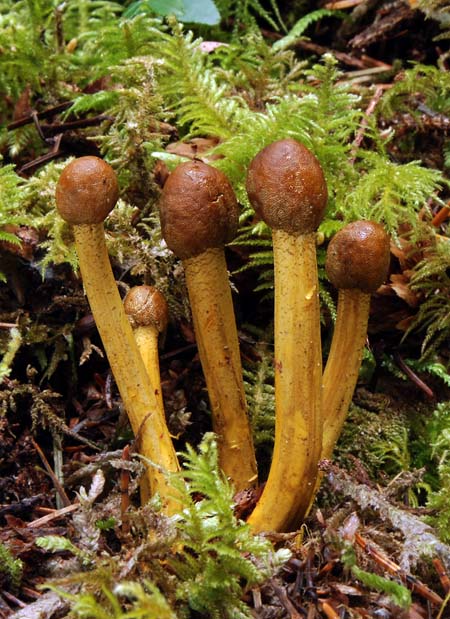 A rare 5 headed Drumstick Truffleclub - Tolypocladium capitatum. © Daniel Winkler, Dec. 2011, Found near Florence, Oregon Coast. Formerly Cordyceps capitata (Holmsk.) Link and Elaphocordyceps capitata (Holmsk.) G.H. Sung, J.M. Sung & Spatafora, now Tolypocladium capitatum (Holmsk.) C.A. Quandt, Kepler & Spatafora is growing from an underground Elaphomyces deer truffle species. Tolypocladium capitatum has immersed perithecia and a capitate, darkish fertile "cap". It seems that T. capitatum is distributed over the whole northern hemisphere. 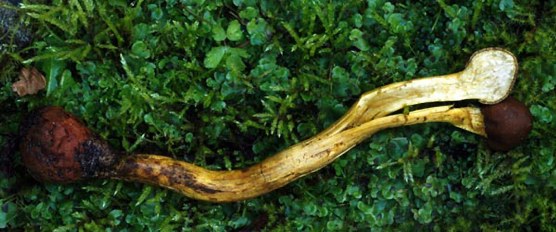 Here a more typical one headed specimen sliced open for display. © Daniel Winkler, Dec. 2011, Found near Florence, Oregon Coast. 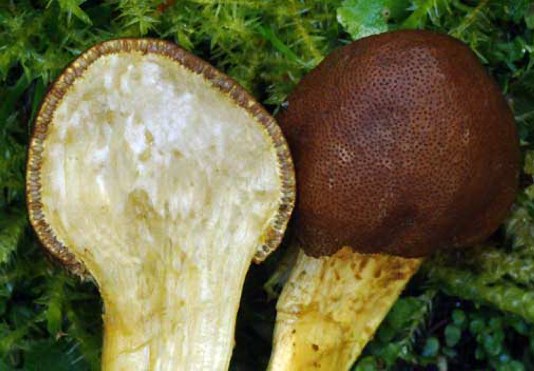 A transect of the fertile head of the Drumstick Truffleclub. Elaphocordyceps capitata's stem is clearly distinguished from the fertile tissue containing the perithecia. Note the tough outer layer in which the perithecia embedded. To the left is a close up. 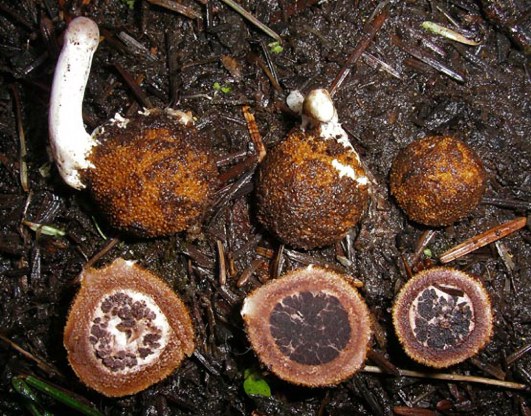 Dissected Elaphomyces (deer truffle, E. muricatus?) with young stroma of Elaphocordyceps capitata sprouting out of the rind. 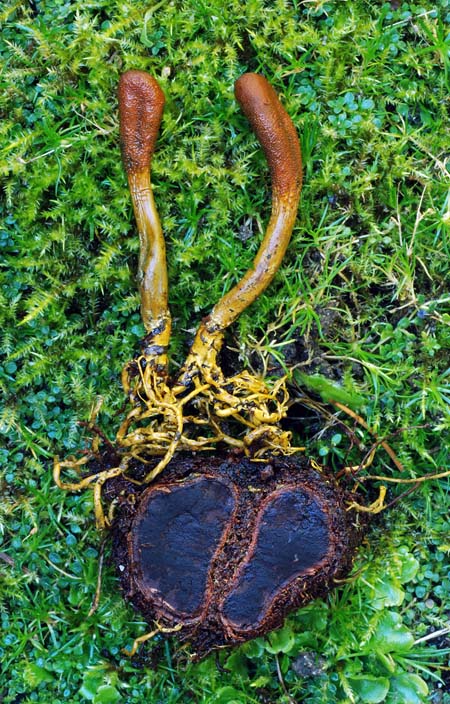 Tolypocladium (Elaphocordyceps) ophioglossoides, Snaketongue Truffleclub on Elaphomyces truffle, that have been dissected. Found on the Olympic peninsular by Christian Schwarz Photo: © Daniel Winkler, Oct. 18, 2011 There has been research in China and Japan on the medicinal propensities of closely related Elaphocordyceps ophioglossoides, which seems to have estrogenic substances.
Cordyceps militaris stroma structure. Photo: © Daniel Winkler, Oct. 18, 2011. |
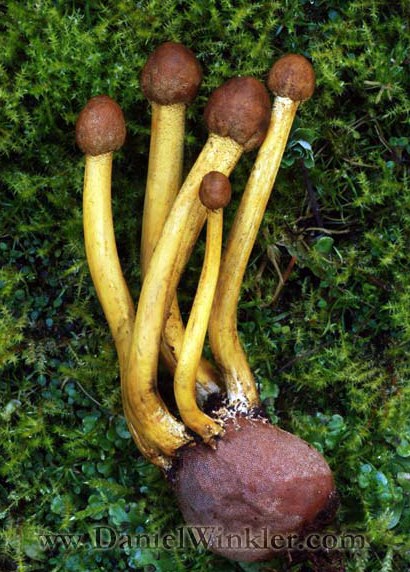 I am not sure what causes the growth of 5 heads from one Elaphomyces granulatus-deer truffle, but I have observed in Ophiocordyceps sinensis that double or multiple heads usually occur after the immature stroma was injured, most commonly fed on by a mycophagous insect. Right next to this specimen grew another one that had half of its stem based chewed off. Photo: © Daniel Winkler, Dec. 2011, near Florence, Oregon Coast. 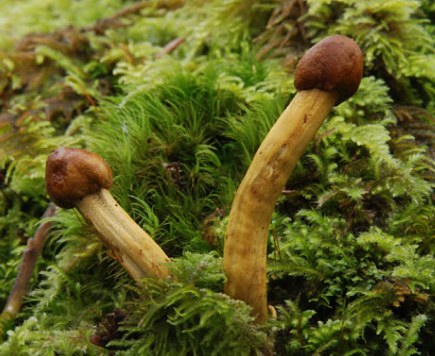 Photo: © Daniel Winkler, Nov. 2008, Olympic Peninsula, WA Here an even closer look: 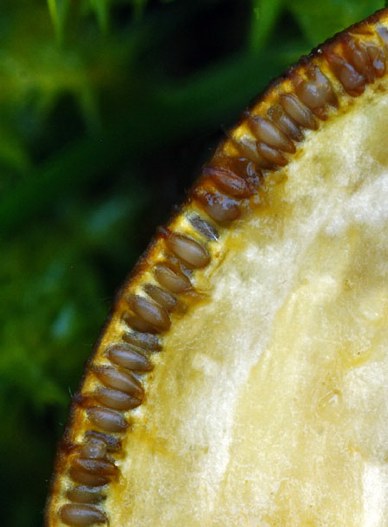 A crusty outer layer protects the immersed perithecia, the spore producing organs that contain the asco-sacs are embedded. Photo: © Daniel Winkler, Dec. 2011, Found near Florence, Oregon Coast. 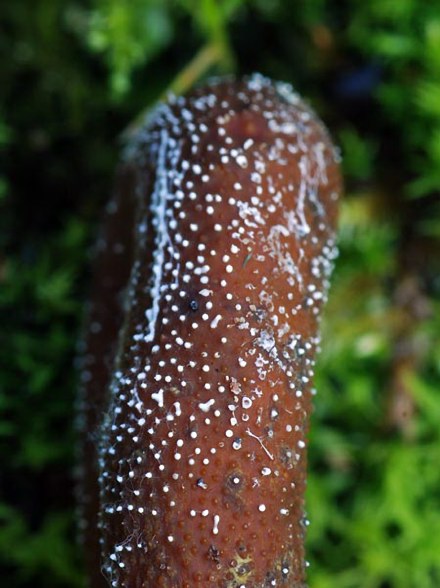 Spores being released from the perithecia of Tolypocladium = Elaphocordyceps ophioglossoides.
Cordyceps militaris (L.) Fr.  Cordyceps militaris on a butterfly pupa found SE of Seattle by Marian Maxwell. Photo: © Daniel Winkler, Oct. 18, 2011.
|
Sources: Quandt, Alisha et al. (2014) Phylogenetic-based nomenclatural proposals for Ophiocordycipitaceae (Hypocreales) with new combinations in Tolypocladium. In: IMA Fungus. Jun 2014; 5(1): 121–134. Sung G-H, Hywel-Jones NL, Sung J-M, Luangsa-ard JJ, Shrestha B, Spatafora JW. (2007) Phylogenetic classification of Cordyceps and the clavicipitaceous fungi. Studies in Mycology 57: 5–59
| |







